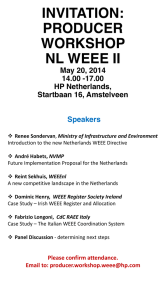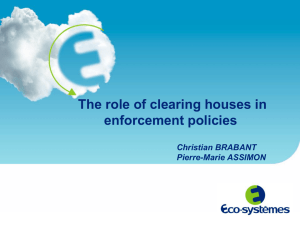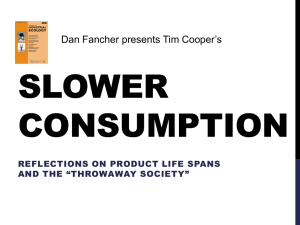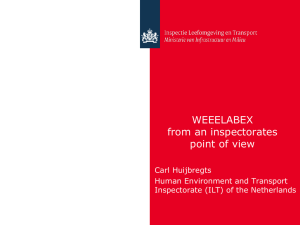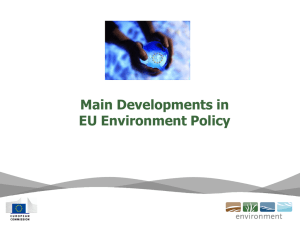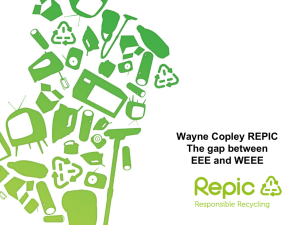120418-The_Recast_of..
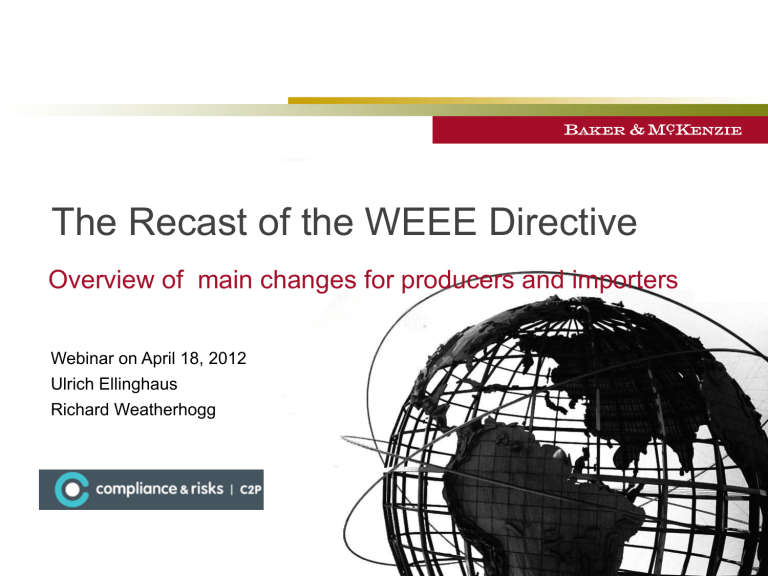
The Recast of the WEEE Directive
Overview of main changes for producers and importers
Webinar on April 18, 2012
Ulrich Ellinghaus
Richard Weatherhogg
Introduction
2
The Existing WEEE Directive 2002/95/EC
– The WEEE Directive 2002/95/EC has been in force since February
2003.
– Its main purpose is to prevent waste from electrical and electronic equipment.
– This shall be achieved by collecting and recycling used e-waste.
– The WEEE Directive introduces the requirement of national collection schemes.
– The costs are imposed upon “ producers ” (i.e. who sells under his own brand or imports).
– With regard to B2B products, “ producers ” and their customers may agree on a different financing.
3
Overview
– Introduction
– Changes of Scope
– Design, Reuse, Collection, Recovery, Waste Shipments
– Registration
– Harmonization?
4
The Need for a Recast
– The main purposes of the WEEE Recast are
– To tackle the fast increasing waste stream.
The initial collection target was 4 kg per year of
WEEE from private households; this turned out to be too low.
– To reduce administrative burdens.
– To ensure coherency with newer legislation and policies
(e.g. New Legislative Framework, Waste Framework
Directive, Ecodesign-Directive, Waste Shipment
Regulation).
5
The Current Status of the WEEE Recast
– The legislative process of the WEEE Directive has not been finalized yet.
– It was time-consuming, because of differing opinions of the
European Parliament and the Council of the European Union
(comprised of the heads of state or government of the EU Member
States).
– However, eventually Parliament and Council arrived at a compromise.
– In January 2012, European Parliament adopted a compromise text.
– It is expected that the Council will approve this text in its current version.
– Once published in the Official Journal of the European Union,
Member States must transpose the new Directive within 18 months.
6
Changes of Scope
7
Categories of EEE
– Currently, WEEE has ten categories of EEE which are in scope
– These categories will be replaced after a six year transitional period
– Recast WEEE will cover all EEE (with certain specific exclusions)
– “ All EEE shall be classified within the categories set out in
Annex III ”
8
Current Categories
1.
Large household appliances (e.g. fridges, washing machines, microwaves, electric radiators, air conditioner appliances)
2.
Small household appliances (e.g. vacuum cleaners, toasters, tooth brushes, clocks)
3.
IT and telecommunications equipment (e.g. mainframes, PCs, laptops, printers, photocopiers, telephones, mobile phones)
4.
Consumer equipment [ and photovoltaic panels ]
(e.g. TVs, radios)
5.
Lighting equipment
6.
Electrical and electronic tools (excluding largescale stationary industrial tools) (e.g. drills, sewing machines, lawn mowers)
7.
Toys, leisure and sports equipment (e.g. handheld video games consoles, video games, sports equipment with electrical components)
8.
Medical devices (excluding all implanted and infected products) (e.g. radiotherapy equipment, ventilators, dialysis equipment)
9.
Monitoring and control instruments (e.g. smoke detectors, thermostats)
10.
Automatic dispensers ( automatic dispensers for hot drinks, money, etc.)
Recast Annex III Categories
(open scope)
– Temperature exchange equipment
– Screens, monitors, and equipment containing screens with surface > 100cm2
– Lamps
– Large equipment (any external dimension >
50cm)
– Small equipment (no external dimension >
50cm)
– Small IT and telecommunications equipment
(no external dimension > 50cm)
9
Six year transitional period
The current 10 EEE categories [incl. photovoltaic panels] with certain transitional exclusions
Recast WEEE enters into force 3 years 6 years
Applies to all EEE which must be categorised within the 6 recast Annex III categories (certain exclusions)
2012 ?
Transitional exclusions
From entry into force the following EEE is excluded:
(a) equipment for
Member State security
(e.g. arms, munitions and war material intended for specifically military purposes)
(b) equipment for which the sole function is to be a part of equipment which is excluded or outside scope
(c) filament bulbs
2015 ?
2018 ?
Review of scope
Within 3 years the Commission must review the scope of the recast.
The review should cover, in particular, application to “ all EEE ” and the parameters for distinguishing between large and small equipment in the Annex III categories.
Commission must report with proposals for changes, if any.
10
Exclusions
• Recast WEEE Directive lists several exclusions not expressly stated in current WEEE Directive
Recast exclusions:
• equipment designed to be sent into space
• large-scale stationary industrial tools (currently excepted from category 6 electrical and electronic tools)
• large-scale fixed installations, except any equipment which is not specifically designed and installed as part of these installations
• means of transport for persons or goods, excluding electric two-wheel vehicles which are not typeapproved
• non-road mobile machinery made available exclusively for professional use
• equipment specifically designed solely for the purposes of research and development that is only made available on a business to business basis
• medical devices and in vitro diagnostic medical devices, where such devices are expected to be infective prior to end of life, and active implantable medical devices (currently excepted from category
8 medical devices)
• These exclusions apply 6 years after entry into force
• In addition, the transitional exclusions will continue to apply 6 years after entry into force
11
Exclusions
Large-scale fixed installations
• Not defined in the current WEEE Directive
• The Commission’s FAQ document provided outline commentary on its interpretation (not legally binding)
• Recast WEEE sets a legally-binding definition
• Recitals to recast WEEE cite the examples of oil platforms, airport luggage transport systems and elevators
• Further clarification forthcoming? New FAQ document?
12
Exclusions
Large-scale stationary industrial tools
• Currently excepted from category 6 electrical and electronic tools
• No legally-binding definition in the current WEEE Directive, although the Commission’s FAQ document provided some outline (non-legally binding) commentary on interpretation
• Recast WEEE contains a legally binding definition:
“ a large size assembly of machines, equipment, and/or components, functioning together for a specific application, permanently installed and de-installed by professionals at a given place, and used and maintained by professionals in an industrial manufacturing facility or research and development facility ”
• Further clarification forthcoming? New FAQ document?
13
Design, Reuse,
Collection,
Recovery, Waste
Shipments
14
Design
– Art 4 WEEE Directive contains some wording on design:
“ Member States shall encourage the design and production of electrical and electronic equipment which take into account and facilitate dismantling and recovery, in particular the reuse and recycling of WEEE, their components and materials ” .
– But this was more a policy statement
15
Design
– Art. 4 WEEE Recast now mentions eco-design requirements (Energy-related products Directive
2009/125/EC)
– In addition, there is an increased focus on re-use:
“ producers do not prevent, through specific design features or manufacturing processes, WEEE from being re-used ”
– This is in line with the waste hierarchy imposed by the
Waste Framework Directive: prevention, preparing for reuse, recycling, other recovery, disposal (priority order)
16
Design
– This is also in line with the “ extended producer responsibility ” for producers “ in order to strengthen the reuse and the prevention, recycling and other recovery of waste ” (Art. 8 Waste Framework Directive)
– It is likely that we will see, on national level, obligations to design products accordingly (see, already adopted, the new German „Recycling Act“). On its basis, the
Government shall adopt Ordinances imposing specific requirements by product group.
17
Reuse
– In addition, Art. 6 Recast specifically requests that Member
States facilitate access to collected waste for third parties, so they may pick appropriate products for re-use:
“ In order to maximise preparing for re-use, Member States shall promote that, prior to any further transfer, collection schemes or facilities, as appropriate, provide for the separation at the collection points of WEEE that is to be prepared for re-use from other separately collected WEEE, in particular by granting access for personnel from re-use centers .
”
18
Collection
– In general, no direct obligation for producers, but for Member States
– Art. 7 WEEE Recast: Minimum collection rate of 45% (4 years after entry into force), increases to 65 % (EEE placed on the market) or
85% (WEEE generated), respectively (after 7 years)
– However, a new obligation is imposed upon distributors for small
WEEE
– Art. 5 Recast Directive: “ distributors provide for the collection, at retail shops with sales areas relating to EEE of minimum 400 m2, or in their immediate proximity, of very small WEEE (no external dimension more than 25 cm) free of charge to end-users and with no obligation to buy an EEE of equivalent type ”
19
Recovery
– Recovery targets of up to 85%
– High targets for re-use and recycling
– These targets do not apply directly to individual companies.
– However: Member States must implement stricter recovery targets for industry and they are under scrutiny by the
European Commission.
– Therefore, they may feel themselves obliged to introduce stricter collection regimes.
– Indirect consequence: „Upgrade“ of national collection and recovery schemes.
20
Treatment
– Additional standards will be imposed for treatment (Art. 8:)
“ The Commission shall, not later than... (6 months after entry into force), request the European standardisation organisations to develop European standards for the treatment, including recovery, recycling and preparing for re-use, of WEEE. These standards shall reflect the state of art.
”
– Producers must provide information about preparation for re-use and treatment for new EEE free of charge (Art. 15)
21
Waste Shipments
– The WEEE Recast does not introduce a new regime for exports of waste.
– It makes a fresh effort to enforce compliance with Waste
Shipment Regulation 1013/2006 (WSR)
– Currently, many shipments of used EEE across borders are not categorized as waste – in contrary to applicable interpretation of WSR
– As a consequence: More shipments will be subject to reporting obligations, obligations to conclude contracts to ensure take-back in case the shipment fails, insurance obligations, approval of transport of hazardous waste etc.
22
Waste Shipments
– Art. 10: “ Exports of waste are only possible if in compliance with
Waste Shipment Regulation 1013/2006 ”
– Art. 23: “ Member States shall ensure that shipments of used EEE suspected to be WEEE are carried out in accordance with the minimum requirements in Annex VI and shall monitor such shipments accordingly. The costs of appropriate analyses and inspections, including storage costs, of used EEE suspected to be
WEEE may be charged to the producers, to third parties acting on their behalf or to other persons arranging the shipment of used EEE suspected to be WEEE.
”
23
Waste Shipments
In order to prove that a shipment does not contain waste:
– Evidence that shipment contains fully functional equipment, destined for direct re-use
– Appropriate protection against damage
OR
– If defective: proof that equipment is sent back for repair with the intention of reuse
Correspondents‘ Guidelines No. 1 on shipments of WEEE have been made hard law and even made more restrictive.
24
Registration
25
The registration process
Current WEEE
National schemes
• Member States have implemented different registration requirements and processes
• Member States have different information and reporting requirements
• Administrative complexities for registrants
Proposed for the recast
Central EU register
• Inter-operational registers
• Producers to register in one
Member State for all their activities in the EU
Adopted in recast WEEE
National registers of producers
• No centralised register, i.e. separate registrations still necessary in each Member State
• Each Member State to provide an online registration facility
• Information requirements set out in
Annex X (i.e. greater consistency)
• National registers to provide links to other national registers
• Commission to establish format for registration and reporting and frequency of reporting to the register
26
Who must register? – Producers and ARs
Producers:
Producers comprise “ any natural or legal person who, irrespective of the selling technique used, including distance communication […]: i.
is established in a Member State and manufactures EEE under his own name or trademark, or has EEE designed or manufactured and markets it under his name or trademark within the territory of that Member State , ii.
is established in a Member State and resells within the territory of that Member State , under his own name or trademark, equipment produced by other suppliers, a reseller not being regarded as the ‘ producer ’ if the brand or the producer appears on the equipment, as provided in point
(i), iii.
is established in a Member State and places on the market of that Member State , on a professional basis, EEE from a third country or from another Member State, or iv.
sells EEE by means of distance communication directly to private households or to users other than private households in a Member State, and is established in another Member State or in a third country.
”
– “’ placing on the market ’ means the first making available of a product on the market within the territory of a Member State on a professional basis ”
– “’ making available on the market ’ means any supply of a product for distribution, consumption or use on the market of a Member State in the course or a commercial activity, whether in return for payment or free of charge ”
– No definition for “ established in a Member State ”
27
Authorised representatives (“ARs”)
Responsible for fulfilling the obligations of a producer in a particular Member State ’ s territory
Appointment:
– Producers defined in limbs (i)-(iii): A Member State must allow any producer (within limbs
(i) – (iii), above) established in another Member State to appoint an authorised representative in its territory
– Distance sellers defined in limb (iv) above: Distance sellers must either be registered in the Member State into which they are selling. If they are not registered, the Member State where they are established must ensure that they appoint an authorised representative in the other Member State
– Potential gap in the requirement for entities selling from non-EU countries
– Instead of appointing and AR, a producer also has the option to become established in the relevant Member State and register itself there
–
An AR must be appointed by written mandate
– Member States must draw up registers of “ producers ” , including distance sellers selling into their territory or their authorised representatives ( “ ARs ” ) and any other authorised representatives appointed in their territory
28
Harmonization?
29
No harmonization of collection schemes
– The Recast will not bring changes to the current collection schemes. They differ significantly from Member State to
Member State.
30
Harmonization of scope
– In the future, all electrical and electronic equipment will be covered. Under the existing Directive, there was oftentimes disagreement between authorities and producers whether a certain product falls within the scope of WEEE.
– No room for interpretation in the future?
– Scope of exemptions is not entirely clear:
– „large-scale stationary industrial tools“
– „large-scale fixed installations“
31
Harmonization of surveillance and enforcement
– WEEE Recast must also be seen in the context of the
European Union ‘s major effort to increase surveillance and enforcement efforts.
– Uneven enforcement and surveillance of compliance amongst Member States was the reason why the EU replaced its „New Approach“ with the „New Legislative
Framework“
– One major aspect of this new policy approach is to increase the pressure on Member States to ensure compliance with existing regulation.
32
Harmonization of surveillance and enforcement
– Art. 18: “ Member States shall ensure that authorities responsible for implementing this Directive cooperate with each other , in particular to establish an adequate flow of information to ensure that producers comply with the provisions of this Directive […] Cooperation shall include, inter alia, access to the relevant documents and information including results of any inspection ”
– Art. 23: “ Member States shall carry out appropriate inspections and monitoring to verify the proper implementation of this Directive.
”
33
Questions and Answers
Baker & McKenzie Partnerschaft von Rechtsanwälten, Wirtschaftsprüfern, Steuerberatern und Solicitors is a professional partnership under German law with its registered office in
Frankfurt/Main, registered with the Local Court of Frankfurt/Main at PR No. 1602. It is associated with Baker & McKenzie International, a Verein organized under the laws of
Switzerland. Members of Baker & McKenzie International are Baker & McKenzie law firms around the world. In common with terminology used in professional service organizations, reference to a "partner" means a professional who is a partner, or equivalent, in such a law firm. Similarly, reference to an "office" means an office of any such law firm.
© Baker & McKenzie
